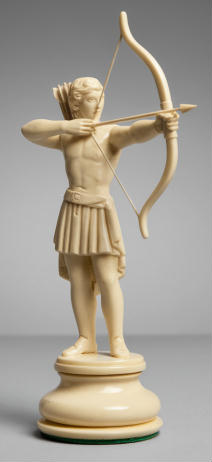Piececlopedia: Bowman
Historical notes

The bowman is a modern invention, invented for the large commercial chess variant Quantum.
Movement
The bowman moves like a non-jumping chess knight to an unoccupied square. Specifically, it moves either one straight and then one diagonal, or one diagonal and then one straight. Therefore it always has available paths to reach its destination square, only one of which need be unblocked for the bowman to make the move. In the diagram below, the bowman can move to any of the green squares, provided that they are unoccupied.The bowman captures by moving as it normally does. If there is a piece located another knight move in the same direction away from the bowman's destination square, then that piece is captured, regardless of intervening pieces. The bowman does not actually move to the square occupied by the captured piece, thus it captures 'from afar.' In the diagram below, the bowman could capture a piece on any of the red squares by moving to the corresponding green square. For example, by moving to d3 (which can be done provided 1) either d4 or e4 is unoccupied by pieces on either side, and 2) d3 is unoccupied), the bowman captures an enemy piece on c1, regardless of an other intervening pieces. The piece on c1 is removed from the board, and the bowman remains on d3.
![]()
![]()
![]()
![]()
![]()
![]()
![]()
![]()
![]()
![]()
![]()
![]()
![]()
![]()
![]()
![]()
![]()
![]()
![]()
![]()
![]()
![]()
![]()
![]()
![]()
![]()
![]()
![]()
![]()
![]()
![]()
![]()
![]()
![]()
![]()
![]()
![]()
![]()
![]()
![]()
![]()
![]()
![]()
![]()
![]()
![]()
![]()
![]()
![]()
![]()
![]()
![]()
![]()
![]()
![]()
![]()
![]()
![]()
![]()
![]()
![]()
![]()
![]()
![]()
![]()
![]()
![]()
![]()
![]()
![]()
![]()
![]()
![]()
![]()
![]()
![]()
![]()
![]()
![]()
![]()
![]()
You can also view the Quantum webpage's own diagrams of movement and capture.
Remarks
The rules for Quantum do not state whether or not capturing is optional. For example, if a bowman moves to a given square, and there is an enemy piece on the capture square, is the bowman obligated to capture it? It is possible that he may not want to, if it would open a useful path for his opponent, and may even be illegal, if it capturing the piece creates a discovered check. In this case, is the bowman forbidden from moving to this square, or can he move without capturing?Note that for the bowman to be able to capture in all eight directions, the minimum board size must be 9x9. In the three versions of Quantum that use the bowman, Quantum II uses a 10x10 board, and Quantum III and Quantum IV use 12x12 boards.
Pieces that can capture from afar tend to be powerful, because they can freely capture pieces regardless of how much they are directly defended. The bowman is an interesting piece because this power is reduced by the bowman's awkwardness of movement and even greater awkwardness of capture; it only captures a piece that is on the opposite corner of a 5x3 rectangle from the bowman, with additional limitations.
In Quantum, the bowman is combined with other standard chess pieces and chess piece combinations to create a variety of new pieces.
This is an item in the Piececlopedia: an overview of different (fairy) chess pieces.
Written by Benjamin C Good. AI image added by Fergus Duniho.
WWW page created: September 17, 1998. Last modified: November 23, 2024.
